Bob Mehlenbeck kept an album of the shots he took during 1931, as well as prints he traded
for with other photographers. The variety of the trains/roads he saw in his hometown of
Peoria, IL was a fascinating array. Some of the services he recorded that year would not
be around for much longer. The depression and increasing miles of improved roads would change
the railroad world dramatically in the space of a few short years. The scans are from the
original contact prints that Bob saved and pasted into his album, I apologize in advance for
any staining of the prints, but they are authentic!
In just four blocks along Water Street (on) Peoria's (river-lakefront), Bob had access to the
carriers serving Peoria Union Station and the Rock Island Depot. There was direct Illinois
Power & Light (IP&L) streetcar service to the Union Station, while the Rock Island station
was just a block or two removed from the IP&L lines running on Washington and Adams. In
addition, Bob had access to the family auto for his railfan excursions. Of course, the other
big player in Peoria passenger and freight transportation was the Illinois Terminal, which
maintained terminal facilities separate from the steam roads, at Washington & Adams. The
images in this piece are presented in chronological order.
Chicago & Illinois Midland (C&IM) 502 at Peoria Union Station on Feb. 12, 1931
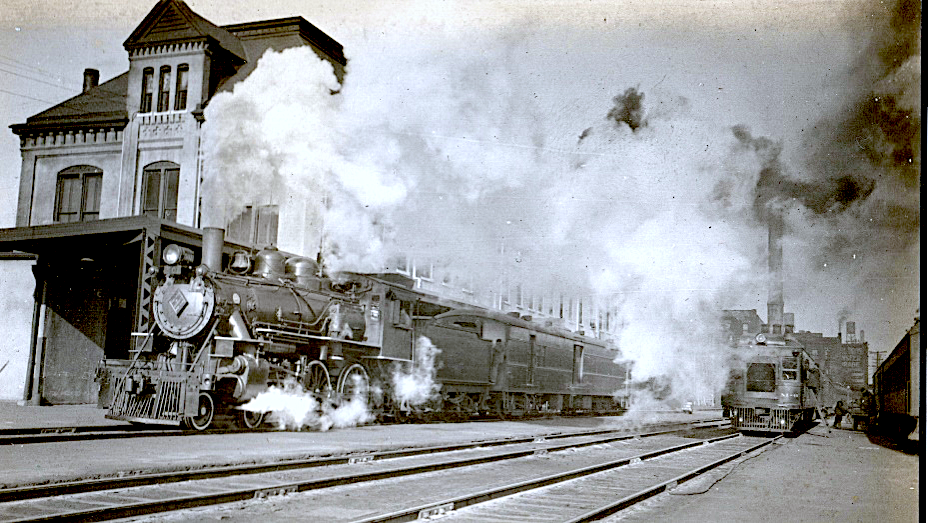
Famous as the last 4-4-0 "American Stadards" built (Baldwin, 1927), C&lM 500-502 were
holding down two daily Peoria-Springfield round-trips at the time of Bob's photo. The road
had only recently dramatically extended its reach by acquiring (during 1926) the Havana-Pekin
and Havana-Springfield sections of the Chicago Peoria & St. Louis. At the same time, the
C&IM acquired one-quarter control of the Peoria & Pekin Union.
Owned by Insull's Commonwealth Edison (since 1905), the C&IM was further able to improve its
passenger service in late 1927 by acquiring new all-steel passenger cars, based on the designs
used on many of sister road's South Shore Line multiple unit cars. Included in this order
were coaches, combines and RPO-baggage cars. C&IM passenger service ended on May 8, 1953.
New York Central (NYC) 3084 at Peoria Union Station on July 4, 1931
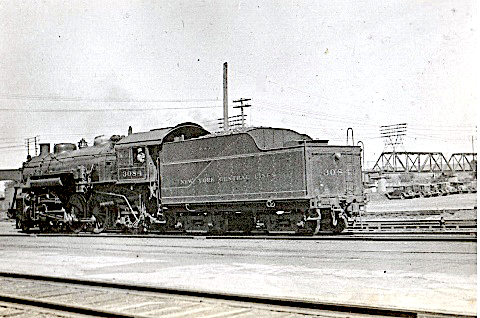
An outstanding example of a well-cared-for and lovingly-striped steam locomotive, NYC K14b
Pacific 3084 has cut off the "Day Express" consist on arrival at Peoria and will head for the
roundhouse for servicing. That's the Illinois Terminal's McKinley Bridge over the Illinois
River in the background.
Built as one of 20 K11b Pacifics (for fast freight service) by Alco in December 1911, the 3084
was one of three of this class the NYC sold to the Peoria & Eastern (P&E) in 1927. Rebuilt at
Beech Grove during July 1929 to a K14b, the 3084 exchanged its original 69" drivers for 72" ones.
Ideal for the quick get-up-and-go required on the essentially local service the "Day Express"
offered on the 211-mile Indianapolis-Peoria line, the 3084 was renumbered to P&E 18 March 1937.
She was sold for scrap in January 1951.
Chicago Burlington & Quincy 2844 at Peoria Union Station on July 7, 1931
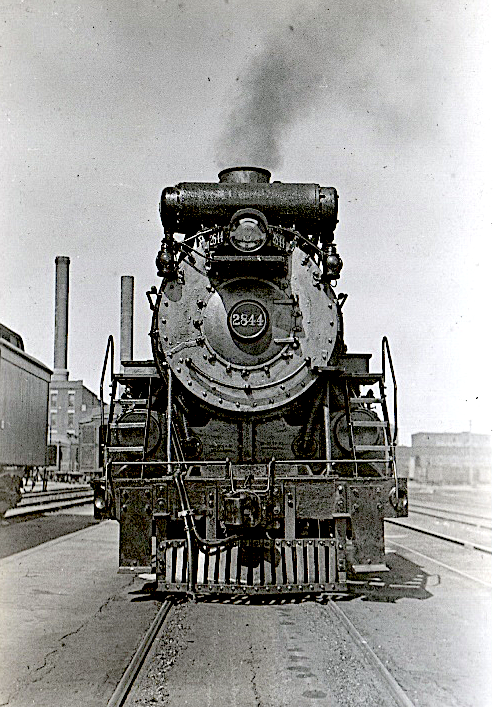
Bob's fine portrait of the handsome face of a Burlington S1a Pacific reminds us of the work
the Q did on the rebuild of its Class S1 Pacifics in 1929. This engine was the last of 45
Stephenson-equipped locomotives Alco had delivered to the Burlington in 1906-07. The objective
of the 1929 rebuild was to provide drier steam, which resulted in greater power output. Total
engine + tender weight went up considerably in this rebuild; an 11% increase to 425,000 pounds.
The 2844 was finally sold for scrap in September 1953.
The 53-mile line linking Galesburg and Peoria still hosted three passenger train round trips
per day at the time of this photo. This line dated to 1855 and by this time already hosted a
variety of locomotive-hauled and gas-electric-operated runs. It would transition to all gas
(later diesel) car runs.
blank
Pennsylvania RR (PRR) 8495 at Peoria Union Station on July 7, 1931

Those well-proportioned Atlantics! An outstanding example of the Pennsy's E7s class of
locomotives, the 8495 had originally been built as a Class E2c, in April 1903 (by Alco) for
the PCC&StL. Rebuilt to the E7s specifications in June 1917, the engine is shown here with
a mbM62 RPO-baggage car and a mP54 coach, substituting for the normally-assigned oil-electric
car on the 174-mile Terre Haute-Peoria line. A total of 92 of the members of the E2a, E2b
and E2c classes were rebuilt to E7s locomotives.
At the time, the normally assigned PRR equipment on this line were the Pullman-Beardmore
oil-electric cars, 4663 and 4664. The reputation of these cars tended toward the maintenance
intensive. The 1928 conversion of this line to gas car service had originally used Brill-built
model 350 cars 4641-4642, with the Pullman-Beardmore cars replaced the Brills the following year.
On August 20, 1932, PRR discontinued the passenger trips west of Decatur. The final passenger
train operation on this branch occurred on January 1, 1949. The Illinois Terminal would purchase
55.6 miles of the Penn Central's Peoria Secondary line effective April 1, 1976.
Toledo Peoria & Western (TP&W) 70 on July 7, 1931
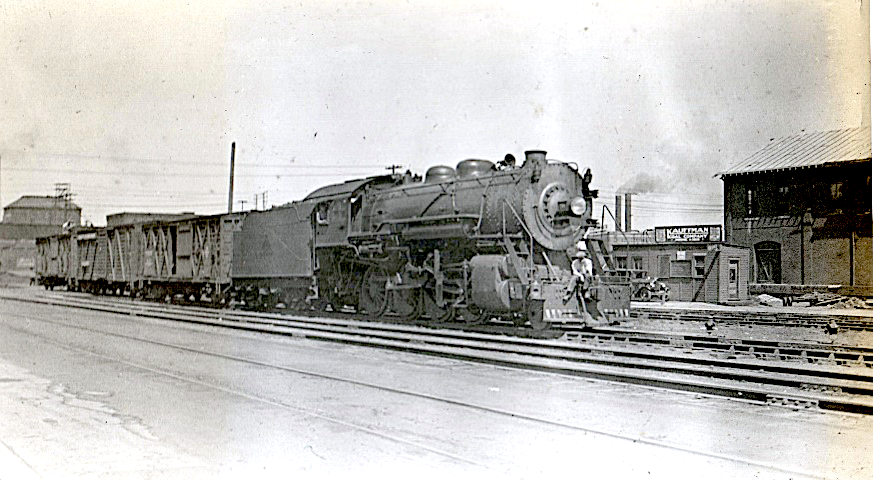
In receivership since mid-1917 (and then under USRA operation from late 1917 until early 1920),
the TP&W struggled through the mid-1920s. Competition from paved roads siphoned-off much of
the road's passenger business, as well as some of its freight traffic. Ordered for sale, the
first sale in December 1925 drew no bids. A second sale (on June 11, 1926) brought George P.
McNear, Jr. to the TP&W. He found a road where 20% of the locomotives were bad-ordered.
In 1927, McNear bought new 2-8-2s from Alco and also looked for other power with which he
could modernize the road. The 70 had been CCC&StL "Big Four" Class G6c 6731 and became TP&W
Class H8 70 in July 1929. One other G6c was sold to the TP&W at the same time, while two G6n
Class 2-8-0s were sold by the Big Four to the TP&W in September 1929. The 70 would work for
the TP&W until being scrapped on April 14, 1949.
TP&W employees struck the road from November 14, 1929 until June 16, 1930. The road saw its
freight traffic fall off by 18% during 1931. The location for this shot of the 70 at work is
around Main St., Peoria, based on the location of the IT bridge in the background.
Rock Island (RI) 817 at Rome, IL on July 19, 1931
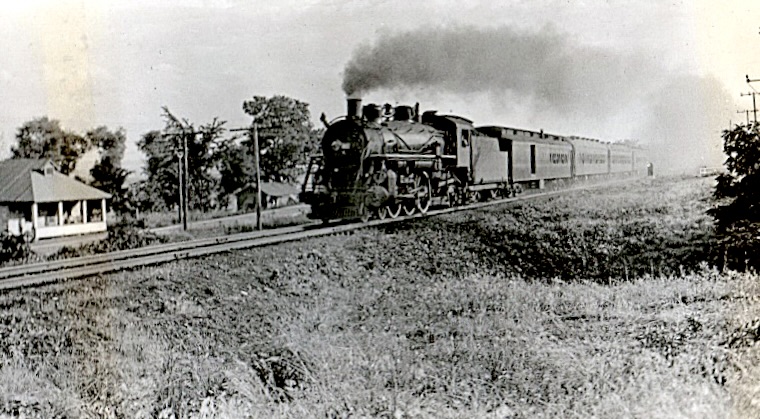
If you've guessed that Train 210 ("the five o'clock Rock" in Bob's parlance) looks like it's
not going to be stopping in Rome (about 15 miles north of Peoria), you've guessed correctly.
Of the eight trains running on the branch at the time, only the two local trains (Trains 221
-222) would stop in Rome.
Rome (about 3.5 miles south of the Rock-Santa Fe crossing in Chillicothe), was on the route
of Illinois Highway 29, running up the west bank of the Illinois River. This highway route
had been established in 1918, linking DePue to Peoria and by 1930 was paved over its full length.
Train 210 is in the care of P28 class Pacific 817 this day. The train had 5 hour, 45 minute
schedule to cover the 161 miles to LaSalle Street Station, Chicago. This equated to an average
speed of 28 mph. Alco built the 817 in 1903 and the remaining members of this class were
retired in 1935-36.
Minneapolis & St. Louis (M&StL) GE-1 at Peoria Union Stn. on July 25, 1931
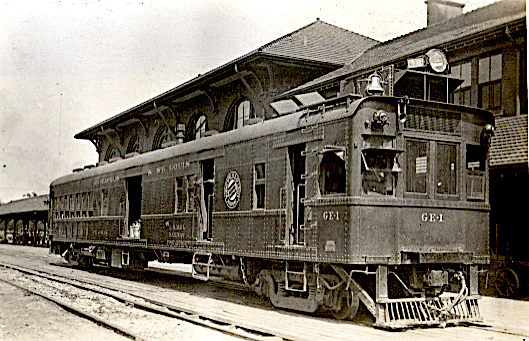
The peak year for gas-electric car deliveries from EMC had been in 1928, when 108 such cars
were delivered. M&StL GE-1 (appropriately enough, named "Peoria") was EMC Order 438, built
in December of 1929, along with sister cars GE-2 and -3. EMC production during 1929 would
total 84 cars. The M&StL cars were 75 feet long (using a body built by St. Louis Car) and
weighed 64 tons. A 300 hp Winton gas engine was installed in each car.
M&StL Eastern Division Trains 19 and 20 covered the 189 miles between Peoria and Oskaloosa,
IA in 6.5 hours, working out to an average speed of 29.1 mph. Train 20 was due in Peoria at
12:45 pm and was given 2.25 hours layover, before heading west as Train 19.
Mixed trains replaced the passenger service on the M&StL's Peoria branch from March 25, 1942.
As for the GE-1, it went into work service from August 1950.
Peoria & Pekin Union (P&PU) 18 at Rock Island Station on July 29, 1931
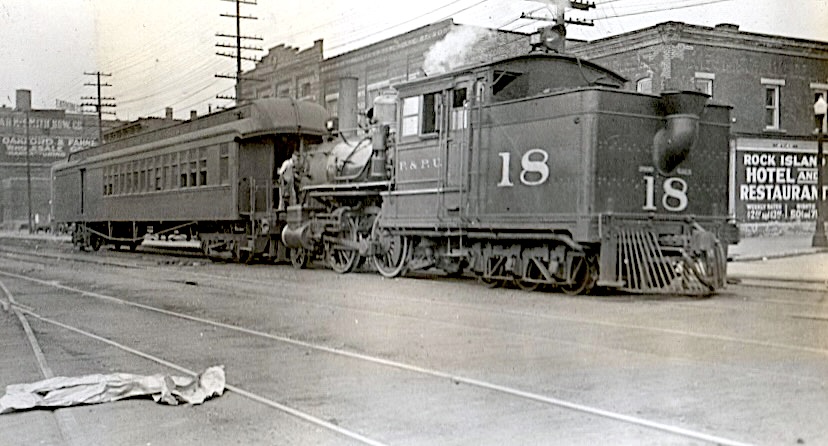
The P&PU began operations in February 1881, providing terminal and switching services for
the railroads entering the Peoria terminal area. At one time the P&PU was providing commuter
train services on both its Eastern Division (a line built in 1872 by the Peoria & Springfield)
and on the Western Division (the Peoria, Pekin & Jacksonville built this line in 1864). The
Western Division services were eliminated first and by the mid-20s, the Eastern Division
service was down to six trips per day. The 9.3 mile run from Pekin included two stops in
Peoria (at Fulton Street and at Union Station) and required 25 minutes one-way, working out
to an average speed of 22.3 mph.
In March 1928, the P&PU acquired a pair of 2-4-6Ts from the Illinois Central (IC), which
allowed them to retire three 4-4-0s that had previously held down the commuter runs. The 18
was ex-IC 1428, while the 19 had been the 1432 on the IC roster. The last day of the P&PU
commuter trains was November 7, 1931, after which the two tank engines were retired.
Peoria Union Station on October 17, 1931
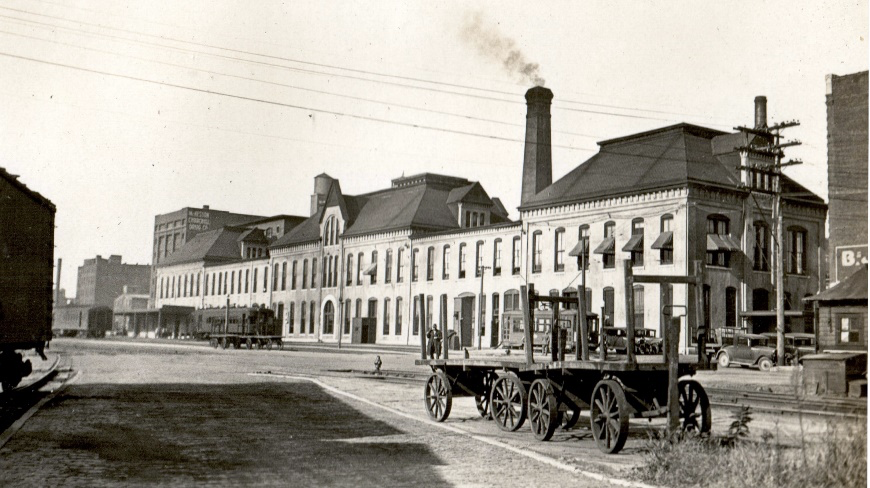
The site of most of the action included in this piece is shown during one of its quieter moments.
To the right, an IP&L Birney (one of 80 the property rostered) can be seen through the baggage
carts. Direct carline service to/from Union Station would cease on June 2, 1940. The
architectural style of the depot is [French] Second Empire design, which was also employed
on the Paris Opera and on the Philadelphia City Hall. A trainshed had covered the tracks
adjacent to the depot building, until removed during 1927 (the victim of a major flood that
inundated the city). The last tenant left Union Station in 1957. The building stood until
destroyed by a fire on August 5, 1961.
New York Central 6900-class at Peoria Union Station on October 22, 1931
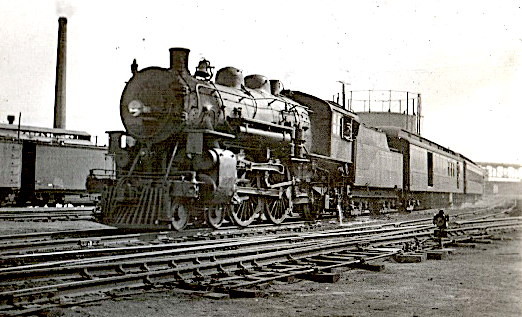
Process of elimination - in reaching out to Rich Stoving for more information on which of
the P&E Atlantics the locomotive at left might have been, he noted that the P&E owned only 10
Atlantics, all acquired from the "Big" Four" between 1917 and 1924. The four Class I-60
Atlantics were all off the roster by 1930, while the I-62s had longer smokeboxes than the
pictured locomotive. One of the I-J class Atlantics had a different front-end ladder
arrangement, meaning that the engine in this picture is either the 6955 or the 6956, both of
which were Class I-J locomotives. Both engines came to the P&E during 1924 and both were
scrapped in 1934.
Acknowledgements: There are so many fans that shared their knowledge
in order to make this piece come together - among them were Ray Breyer, Doug Harding, Doug Kisala,
Clark Propst, Bruce Smith, Rich Stoving and Richard Wallis. A couple of Paul Stringham's books,
the ones on Peoria streetcars and on the TP&W, were also essential to this story. Wes Barris'
"Steam Locomotive" site was also an excellent reference. Several other on-line sources were
also consulted. The "Official Guide" from September 1930 was also used extensively to document
train operations and consists, while the February 1924 "Guide" was of use in determining how
train operations had changed over that time period.
|









